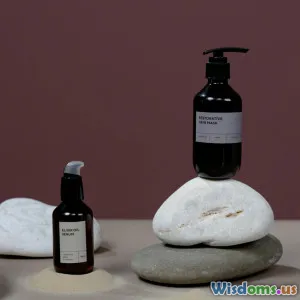
Oil Versus Cream Which Moisturizer Works Best For You
10 min read Explore whether oils or creams are best for your skin with a detailed breakdown of benefits, drawbacks, and tailored advice for all skin types. (0 Reviews)
Oil Versus Cream: Which Moisturizer Works Best For You?
Introduction
Moisturizing your skin is a fundamental step in any skincare routine, but the debate between using oils versus creams has leaving many asking: which one truly works best for me? As the skincare industry evolves, so does the variety of products, their formulations, and promised benefits. Oils and creams often evoke contrasting images—luxurious, naturally-derived oils versus rich, emollient creams—but beneath these labels lies a nuanced science and practical effectiveness corresponding to skin types, needs, and preferences.
In this comprehensive guide, we’ll break down the differences between oils and creams, analyze their benefits and potential drawbacks, and help you determine which moisturizer aligns best with your unique skin profile.
Understanding Moisturizers: Oils and Creams Defined
What Are Facial Oils?
Facial oils are concentrated plant-based or mineral oils that mimic the skin's natural sebum barrier. Common examples include jojoba oil, argan oil, rosehip seed oil, and squalane. These oils help replenish lipids, protect against environmental damage, and lock moisture in.
The unique trait of oils lies in their composition—primarily fatty acids—which serve as emollients, meaning they soften and smooth the skin's surface by filling the spaces between skin flakes.
What Are Creams?
Creams are emulsions combining water and oils, often enriched with additional ingredients like humectants (e.g., glycerin, hyaluronic acid) that attract moisture. Because of their dual-phase formula, creams provide hydration via water and create a protective barrier via oils.
Creams tend to have thicker textures compared to oils and are formulated to suit different skin conditions ranging from dry to oily.
Benefits of Facial Oils
Deep Nourishment and Repair
Oils deliver essential fatty acids such as omega-3 and omega-6, which are crucial for maintaining healthy skin membranes. According to a study published in the Journal of Clinical and Aesthetic Dermatology (2016), these fatty acids help reduce inflammation and boost skin repair mechanisms.
Lightweight and Fast Absorbing
Many oils, particularly non-comedogenic ones like rosehip and squalane, absorb quickly without leaving a greasy residue, making them excellent for daytime use or warmer climates.
Enhanced Glow and Natural Radiance
The light-reflecting properties of oils often impart a subtle glow. Users frequently report that facial oils provide a dewy, youthful look without makeup.
Targeted Skin Benefits
Different oils carry unique active compounds. For example:
- Tea tree oil: Known for antibacterial properties, beneficial for acne-prone skin.
- Argan oil: Rich in vitamin E, supports anti-aging.
- Marula oil: High in antioxidants, great for dry or mature skin.
Sustainability and Purity
Many modern facial oils prioritize natural and organic sourcing, appealing to consumers seeking clean beauty with minimal synthetic chemicals.
Benefits of Facial Creams
Superior Hydration
Creams contain humectants like glycerin that pull moisture from the environment into the skin's stratum corneum (outer layer). This hydration aspect is critical for combating dryness, especially in cold or air-conditioned environments.
Protective Barrier
Thanks to their emollient oils and occlusive ingredients—like shea butter or petrolatum—creams help lock moisture in and shield skin from environmental aggressors and pollutants.
Variety and Customization
Creams offer a wide range of textures and formulations:
- Light gels for oily skin
- Rich balms for dry, flaky skin
- Specialized formulations including SPF, anti-aging actives (retinoids, peptides), and antioxidants.
Adaptability for Skin Concerns
Targeted creams address specific skin conditions such as eczema, rosacea, or sensitive skin via calming ingredients like colloidal oatmeal or ceramides.
Proven Track Record
Many dermatologists recommend creams as the mainstay of daily skincare due to their hydration and barrier-repairing properties. A 2019 review in Dermatology Reports emphasized creams' role in restoring skin barrier integrity in sensitive and atopic populations.
Which Is Better for Your Skin Type?
Oily and Acne-Prone Skin
Contrary to misconception, oily skin can benefit from facial oils—particularly non-comedogenic varieties like squalane or hempseed oil. They balance skin sebum, soothe inflammation, and reduce breakouts.
Creams can sometimes feel heavy or clog pores if they contain occlusive ingredients not suited for oily skin. Lightweight, water-based gels or lotions with mattifying agents might be better.
Example: Popular dermatologist Dr. Anjali Mahto advises "Oils like rosehip can calm acne scars, while lightweight moisturizers complement oily skin." (Source: British Association of Dermatologists)
Dry and Dehydrated Skin
Both oils and creams shine here but serve different roles. Facial oils replenish lipid barriers and soothe tightness, while creams supply necessary water content. Layering a lightweight cream with a nourishing oil might offer optimal benefits.
For harsh winters, richer creams with occlusives create a vital moisture seal.
Example: A 2021 consumer study by Allure found that users with dry skin noted improved hydration and reduced flakiness when adding facial oils alongside creams.
Sensitive Skin
Sensitive skin types usually gravitate towards creams formulated with gentle, fragrance-free ingredients. Oils with known irritants (e.g., citrus oils or synthetic fragrances) may exacerbate reactions.
However, soothing oils like calendula or chamomile-infused oils can calm redness and promote healing.
Aging and Mature Skin
Both oils and creams contribute to anti-aging routines. Oils provide antioxidants and lipids critical for nourishing declining barrier function, while creams deliver peptides and retinoids integrated within hydrating bases.
Combining anti-aging creams with antioxidant-rich oils offers synergistic benefits.
Practical Tips for Choosing and Using Moisturizers
Patch Testing
Always begin with a patch test to check for any allergic or adverse reactions, especially with potent oils or creams containing active ingredients.
Ingredient Transparency
Opt for products with clearly disclosed ingredients and avoid potential irritants:
- For oils: prefer extra virgin or cold-pressed, minimally refined options.
- For creams: watch out for alcohol, heavy silicones, or parabens if you have sensitive skin.
Application Strategy
- Oils can be applied after toner/essence but before or after cream depending on texture and preference.
- Layer creams over serums and finishes with sunscreen during daytime.
Storage and Shelf Life
Oils can oxidize over time; store in dark, cool places to preserve efficacy. Likewise, creams have expiration dates and should be used promptly after opening.
Conclusion
Deciding between oils and creams is less about one being universally better than the other, and more about understanding your skin’s specific needs and texture preferences. Facial oils excel as lipid-replenishing, antioxidative powerhouses, perfect for dry, mature, or sensitive skin when chosen wisely. Creams deliver hydration through water-based components, with protective properties suited especially for dry and sensitive conditions.
Experts often recommend integrating both into skincare routines—using creams for foundational hydration and barrier support, and oils as boosters or targeted treatments.
Equipped with the knowledge about ingredients, functions, and skin compatibility, you can confidently select the moisturizer that will enhance your skin’s health, appearance, and comfort.
Ultimately, personal experimentation with mindful product selection remains key to unlocking your skin’s radiant potential. Moisturize smartly, and your skin will thank you.
References
- Zasada, M., Budzisz, E. (2019). "The role of fatty acids in the skin barrier function." Journal of Clinical and Aesthetic Dermatology.
- Anjali Mahto, British Association of Dermatologists, skincare insights.
- Dermatology Reports (2019). "The effectiveness of emollient creams in restoring skin barrier integrity."
- Allure Consumer Study (2021). "Effects of facial oils in hydration improvement."
Rate the Post
User Reviews
Popular Posts















